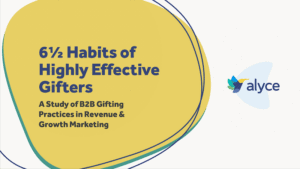
I spent the first 10+ years of my career in food and beverage services, and my greatest takeaway from that experience, besides my treasure trove of great campfire stories, was how to get the front of the house to work in harmony with the back of the house. Typically the front and the back of the house at a restaurant are constantly at odds because they operate from different vantage points within the business. This juxtaposition recently got me thinking: alignment between demand generation and business development teams can be much like managing both sides of the house. When done well, average check sizes soar (ARR), tables turn in lightning speed (sales velocity), repeat rates climb (customer retention), and your Yelp! ratings are all 5 stars (G2 reviews). But when marketing and sales are misaligned because they are operating in silos and executing on separate strategies, your kitchen can go up in hypothetical flames.
I often think of marketing as the front of the house in our business – responsible for greeting guests as they come through our door and ensuring their first impression of our establishment is a memorable one. Sales is back of the house – responsible for developing a delicious menu that compels the customer to order one of everything and come back to dine multiple times a week. Knowing you’re only as good as the other half of the business operation you support, here are the top eight ways our team at Alyce has been able to align our demand generation and business development functions and build a culture of shared responsibility, empathy and impact:
8 Tips for Creating Alignment between Demand Gen and Business Development
1. Get to know the person behind the BDR persona
As soon as a new BDR or SDR joins up, take them out to lunch. Get to know their story; what makes them tick, what motivates them, what are they looking for in this next step of their career, what are they excited to contribute to, what initial ideas do they have for the business.
After this initial meet up, continually engage with them without always having an ask attached to it. Slack them every now and again to check in on how they are doing, personally, or professionally. Grab a coffee or take a walk around the block together and talk about their career goals they outlined on Day 1. Take an interest in who they are as individuals and what their #5to9™ passions are, and reference those in conversations.
This will establish a unified relationship and will make your next ask (i.e. asking them to put together an event invite list or work a trade show booth) so much more well-received.
2. Align your performance goals
Once you have aligned your people, it’s imperative that demand generation and business development align their goals. The success of both team’s efforts should be evaluated in the same way.
For instance, if a demand gen team is measured on MQLs but BDRs on meetings booked or opps opened, your strategies will butt heads. Demand gen will just want to fill the funnel, which leaves BDRs frustrated about quality. It’s even worse when comp structures are misaligned which leads to a serious conflict of motivations.
At Alyce, we’ve aligned our demand gen and business development efforts toward opportunity creation. From our perspective, it only matters how effective our collective efforts are at driving engagement at key accounts and opening opportunities within them. We need to be rowing in the same direction to effectively move the business forward.
3. Create shared metric visibility
Take your unified goals and work with sales or revenue ops to build a shared dashboard that tracks performance toward them. Then work with sales management to use this dashboard to focus on training and optimization for the BDR team. Nobody wants to babysit (or feel babysat). Instead, put the data in the BDR’s hands and empower them to make their own decisions based on what they are seeing in the numbers.
Simultaneously these metrics should also help inform the demand generation team’s programs and campaigns and where they should be focusing their top of funnel efforts to drive maximum business impact.
4. Build a culture of collaboration
One of our sales managers always says, “You’ll get there faster alone but further together.” Silos are detrimental to meaningful progress. While you may be able to move more quickly by writing prospecting messaging, developing a BDR schedule, or evaluating new technology by yourself, the quality of the output will always suffer, as will the adoption of it when it comes time to hand over the reins.
Create a structure that allows for both sales and marketing to collaborate on these initiatives and you’ll see a sticker long term response. Also, ensure you have a feedback loop in place for continued refinement after this initial push and collaboration.
5. Build a process for constructive feedback
BDRs are the heartbeat of your pipeline and have the strongest pulse on your prospects. As a result, they are often the first to identify trends and shifts in the market. Don’t close yourself off to that direct intel! It’s your secret weapon to stay sharp.
Create forums for them to express what is and isn’t landing with prospects and harvest their ideas to improve programs, strategy, and positioning. At Alyce, we have a few different channels we utilize to collect this real time feedback and action it on the marketing side:
- Private Slack group for just BDRs and Demand Gen team – we use this channel to candidly talk through in the moment feedback we are hearing from prospects on messaging, collateral etc. and ways we can improve.
- Bi-weekly power syncs between marketing and sales – run by demand gen, marketing uses this meeting to inform sales on strategies, programs, tools and processes we are developing to help them build more pipeline. This is a great group forum to solicit feedback on our approach.
- Weekly sales manager and demand gen manager meeting – we use this forum to bubble up what the boots on the ground are hearing in our sales and marketing teams to better align and enable ourselves around our end goals.
- Spontaneous drop-ins – whether it’s joining a standing sales meeting, or hopping on a call listening exercise, it’s important that marketing is staying close to the work sales is doing so they can be more collaborative partners.
It’s important you establish these preferred channels of communication and stick to those using a repeatable structure. Use these channels for bidirectional communication between your BDR and demand gen teams. Try to prevent siloed communications as much as possible which can leave people feeling in the dark and that they don’t have the full picture. Which leads me to my next tip…
6. Contextualize your asks
Anytime you are activating your BDRs on behalf of a marketing campaign you are running, give them context for the ask in a way that relates to their purview of the business. Why is it so important to follow up with that list of webinar leads today and how will it help them reach their comp goals? Why should they promote this piece of content on social media and how will it increase their own personal brand online?
You find it difficult to do your job without the full picture in mind so it’s your responsibility to illuminate how their contributions fit into your picture.
7. Highlight contributions in public forums
Being a BDR can be a grind and you need to highlight the bright spots in a day generally filled with a lot of “no.” Our culture at Alyce is to always “Gift First, and Give Consistently” and that applies tenfold to praise. Use every opportunity to acknowledge a job well done and be sure to do it in a public forum for all to celebrate and see.
Whether it’s in a company all-hands meeting or company-wide Slack group, say thank you and reinforce great behaviors you see. A pat on the back shouldn’t only come with an opened opp.
8. Walk a mile in their shoes
Every so often, shadow a BDR for a day, or at very least join one of their prospect calls. Understanding what a day in the life is like for a BDR will help change your frame of reference when activating them to help support your marketing campaigns. A bit of empathy and shared understanding of the constraints and conditions of the BDR function goes a long way.
These steps have allowed our demand generation and business development teams to stay in lockstep with our hyper-growth, driving a 2.5x increase in pipeline generation YoY. Maintaining this tight alignment takes work, but the more effort you can put in upfront to put the right structures, processes, and mindsets in place, the easier it will be for you both to crush your revenue goals and cheers after a long day in a hot kitchen!





